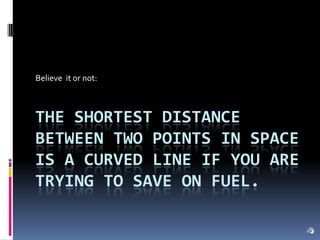
Theshortestdistancenarrated
- 1. Believe it or not: The shortest distance between two points in space is a curved line if you are trying to save on fuel.
- 2. What is an orbit? An orbit is the path an object travels around a point. An orbit is also the balance between the pull of gravity on an object compared to the speed and direction of the object. An object in low Earth orbit is moving at 5 miles per second. The pull of gravity is 32 feet per second toward the Earth. The Earth curves 32 feet for every 5 miles you go out. So, if an object is moving at 5 miles per second, and in that time it falls 32 feet, and the Earth curves 32 feet for every 5 miles you go out, the spacecraft is still 32 feet above the Earth after the 5 miles it moved forward in one second.
- 3. Low Earth Orbit 5 miles forward and drop of 32 feet 5 miles forward and drop of 32 feet NOT TO SCALE
- 4. What would happen… In essence, you have a balance between Inertia (the force forward on the object) and the pull of gravity. To achieve a higher or lower orbit, what are you going to have to change? Do you change the inertia of the spacecraft or the gravity of the Earth? If you increase the inertia (push the spacecraft forward) it will achieve a higher orbit. If you decrease the inertia (slow the spacecraft down by firing rockets in the opposite direction of the orbit) it will achieve a lower orbit or fall to the surface.
- 5. Everything that goes up… In space a straight line may be the shortest distance between two points but it is also the most costly in fuel. If you want something to go straight up you will need to constantly push the object up. As the object goes up gravity wants to pull it down so you will need to keep pushing on it. You will constantly have to fire engines using up fuel and the fuel is heavy so you need more fuel to produce thrust to counter the weight….
- 6. If something is in orbit… One you have an object in orbit it will stay in orbit unless something happens to it. Remember Newton’s First Law of Motion: an object in motion tends to remain in motion unless acted upon by an outside force. So, once an object is in orbit you do not need to constantly push it forward. What happens if an object is in orbit and you add to its inertia?
- 7. Adding inertia When you add inertia (an engine burn in the direction of travel) the orbit will become elliptical and one end of the orbit will move farther away.
- 8. Putting this together: Instead of sending something to the Moon in a straight line, you can increase its orbit until the new orbit intercepts the Moon. Once it runs into the Moon’s gravity it will fall toward the Moon in a curved path putting it in orbit around the Moon.
- 9. Trans Lunar Injection (TLI)
- 10. Orbit with a boost!
- 11. What about other planets? The same process would be used to reach another planet.
- 12. Hoffman Transfer Orbit The Hoffman Transfer Orbit sends an object on a highly elliptical orbit that, if set up correctly, will intercept another object. This transfer orbit uses less fuel than traveling in a straight line but takes longer to get to your destination.
- 13. So… If you want to send a probe, lander or satellite way from the Earth you have to put it in a highly elliptical orbit. If you want it to have a stable higher orbit you will need to fire the engines in the direction of the new orbit when it reaches the proper distance from the Earth. To get to the Moon you will need to go 25,008MPH. To get to Mars you will need to go 94,891 mph.
- 14. And So: If you want to land something on Mars you are going to have to go from 94,000 miles per hour to zero in a very short period of time. Not only that but your spacecraft or you will have to survive these changes.
- 15. Credits A Crewed Mission to Mars... http://nssdc.gsfc.nasa.gov/planetary/mars/marslaun.html Apollo lunar landing launch window: The controlling factors and constraints http://history.nasa.gov/afj/launchwindow/lw1.html The Apollo Flight Journal: Lunar Orbit Rendezvous http://history.nasa.gov/afj/loressay.htm Flight to Mars: How Long? Along what Path? http://www-istp.gsfc.nasa.gov/stargaze/Smars1.htm